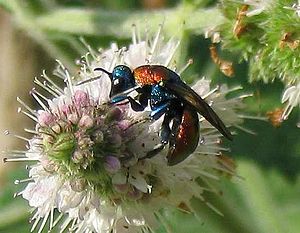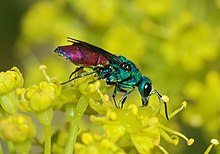Gold wasps
| Gold wasps | ||||||||||||
|---|---|---|---|---|---|---|---|---|---|---|---|---|

Sand wasp ( Hedychrum nobile ) |
||||||||||||
| Systematics | ||||||||||||
|
||||||||||||
| Scientific name | ||||||||||||
| Chrysididae | ||||||||||||
| Latreille , 1802 | ||||||||||||
| Subfamilies | ||||||||||||


The wasps (Chrysididae) together with the Platt wasps (Bethylidae), dryinidae (Dryinidae) and the families Sclerogibbidae, Embolemidae, Plumariidae and Scolebythidae the superfamily chrysidoidea within the aculeata (Aculeata). More than 4000 species are known worldwide , in Central Europe the golden wasps are represented by around 120 species.
features
With their striking, lively shiny metallic ( iridescent ) coloration, the golden wasps are among the more conspicuous representatives of the hymenoptera, even if the European species hardly reach ten millimeters in body size. Many species are even smaller than five millimeters.
The golden wasps differ from other wasps by reducing the number of visible limbs of the abdomen to 5 or fewer. The remaining segments are telescoped into one another and form a laying tube in the females and a genital tube in the males, which are usually drawn into the abdomen and are not visible. The poison sting has withered.
The antenna whip is eleven-limbed, it sits on a pedicellus that is connected to the basal limb (scapus). The labial palps are tripartite, the maxillary palps consist of 5 limbs.
There are no closed cells on the hind wings .

Way of life
All golden wasps have a parasitic way of life, albeit in different forms: there are brood parasites , similar to the cuckoo bees , in which the larva kills the host larva and then feeds on the food supply , and parasitoids that attack the adult larvae or pupae of the host species. Numerous stinging voices from the groups of solitary folded wasps , digger wasps or bees come into question as host species .
Systematics
The golden wasp family comprises a total of 83 genera. These are grouped into 5 subfamilies, if one adds the subfamily Parnopinae , which used to be known as the tribe Parnopini within the subfamily Chrysidinae . In the Amiseginae , Cleptinae and Loboscelidiinae the males have 5 visible abdominal segments, the females 4. The males of the Parnopinae have 4, the females 3. In the tribe Allocoeliini of the subfamily Chrysidinae, only 2 tergites and 3 sternites are visible in both sexes . The other tribes of this subfamily each have 3 abdominal segments in both sexes.
As of September 22, 2014
- Subfamily Cleptinae
- Subfamily Amiseginae
- Genus Adelphe
- Genus Afrosega
- Genus Alieniscus
- Genus Amisega
- Genus Anachrysis
- Genus Anadelphe
- Genus Atoposega
- Genus Baeosega
- Genus Bupon
- Genus Cladobethylus
- Genus Colocar
- Genus Duckeia
- Genus Exopapua
- Genus Exova
- Genus Imasega
- Genus Indothrix
- Isegama genus
- Genus Kimseya
- Genus Kryptosega
- Genus Leptosega
- Genus Magdalium
- Genus Mahinda
- Microsega genus
- Genus Myrmecomimesis
- Genus Nesogyne
- Genus Nipponosega
- Genus Obenbergerella
- Genus Perissosega
- Genus Reidia
- Genus Rohweria
- Genus Saltasega
- Genus Serendibula
- Subfamily Loboscelidiinae
- Genus Loboscelidia
- Genus Rhadinoscelidia
- Subfamily Chrysidinae
- Allocoeliini tribe
- Genus Allocoelia
- Tribe Elampini
- Allocoeliini tribe
- Genus Adelopyga
- Genus Diplorrhos
- Genus Elampus (European)
- Genus Exallopyga
- Genus Haba
- Genus Hedychreides
- Genus Hedychridium (European)
- Genus Hedychrum (European)
- Genus Holophris
- Genus Holopyga (European)
- Genus Microchridium
- Genus Minymischa
- Genus Muesebeckidium
- Genus Omalus (European)
- Genus Parachrum
- Genus Prochridium
- Genus Pseudolopyga
- Genus Pseudomalus (European)
- Genus Xerochrum
- Tribe Chrysidini
- Genus Allochrysis
- Genus Argochrysis
- Genus Caenochrysis
- Genus Ceratochrysis
- Genus Chrysis (European)
- Genus Chrysura (European)
- Genus Chrysurissa
- Genus Euchroeus (European)
- Genus Exochrysis
- Genus Gaullea
- Genus Ipsiura
- Genus Neochrysis
- Genus Odontochrydium
- Genus Pentachrysis (European)
- Genus Pleurochrysis
- Genus Praestochrysis (European)
- Genus Primeuchroeus
- Genus Pseudospinolia (European)
- Genus Spinolia (European)
- Genus Spintharina (European)
- Genus Spintharosoma
- Genus Stilbichrysis
- Genus Stilbum (European)
- Genus Trichrysis (European)
- Subfamily Parnopinae
- Genus Cephaloparnops
- Genus Isadelphia
- Genus Parnopes (European)
Types (selection)
- Chrysis bicolor
- Blue-green-red gold wasp ( Chrysis fulgida )
- Common gold wasp or fire gold wasp ( Chrysis ignita )
- Chrysis inaequalis ( Dahlbom , 1845)
- Snail shell wasp ( Chrysis trimaculata )
- Variegated golden wasp ( Chrysis viridula )
- Copper gold wasp ( Chrysura cuprea )
- Cleptes nitidulus ( Fabricius , 1793)
- Hedychrum ardens ( Coquebert , 1801)
- Sand wasp ( Hedychrum nobile )
- Pink gold wasp ( Hedychridium roseum )
- Pseudomalus auratus ( Linnaeus , 1758)
- Blue gold wasp ( Trichrysis cyanea )
Individual evidence
- ↑ Chrysidid Morphology at Chrysis.net, interim version of August 28, 2013, accessed on September 22, 2014
- ^ A b GL Agnoli & P. Rosa Chrysidid Systematics at Chrysis.net, interim version of January 10, 2010, accessed on September 22, 2014
literature
- Rolf Witt: Wasps. Vademecum Verlag, Oldenburg 2009, ISBN 978-3-9813284-0-0 .
